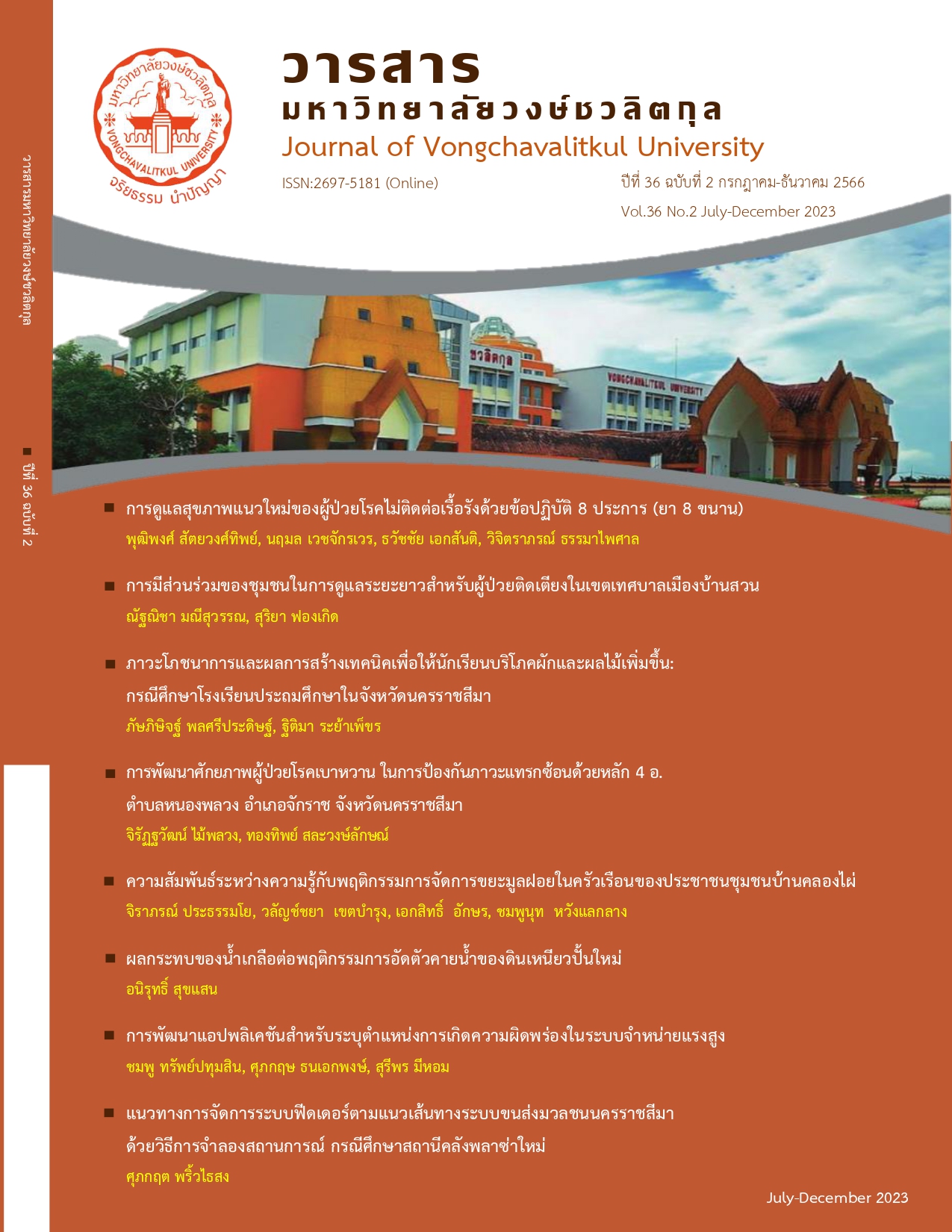Effect of Saline Water on Consolidation Behavior of Reconstituted Clay
Keywords:
Consolidation, Reconstituted Clay, Saline Water, Coefficient of PermeabilityAbstract
Objective: This study presents the evaluation of the effect of saline concentration on the consolidation behavior of reconstituted clay in Nakhon Ratchasima Province.
Method: The saline water was the sodium chloride (NaCL) solution at 0.5, 1.0, and 1.5 M was used as pore fluid. The clay was reconstituted by mixing with distilled water and saline water at the anticipated concentrations. The 1-D consolidation test and soil consistency limit were performed to evaluate the effect of saline water. The initial water content for consolidation samples was desired at 1.5-2.0 times their liquid limit.
Results: The result showed that the increase in the concentration of saline water caused the decrease of liquid limit while the concentration of saline water had a marginal effect on the plastic limit. The coefficient of consolidation (Cv) increased when saline water was as pore fluid. The linear relationship was found in the void ratio versus the logarithm of effective vertical stress. The compression index (Cc) decreased with increasing saline water concentration. The permeability increases with the increased concentration of saline water compared to the same void ratios. The normalization by the void ratio at the liquid limit indicated that all clay with saline water as a pore fluid fit a unique permeability relationship
References
Ajmera, B. and Tiwari, B. (2012) Consolidation Characteristics of Soft Clays with Saline Water as a Pore Fluid, Geotechnical Special
Publication 225, 1223-1232, DOI: 10.1061/9780784412121.126.
Dafalla, M. (2021). Effect of Fluid Chemistry on the Consolidation and Hydraulic Conductivity of Sand-Clay Liners. Sustainability, 13(20), 11213. Retrieved from https://www.mdpi.com/2071-1050/13/20/11213
Di Maio, C., Santoli, L., & Schiavone, P. (2004). Volume change behaviour of clays: the influence of mineral composition, pore fluid
composition and stress state. Mechanics of Materials, 36(5), 435-451. doi:https://doi.org/10.1016/S0167-6636(03)00070-X
Horpibulsuk, S., Shibuya, S., Fuenkajorn, K., & Katkan, W. (2007). Assessment of engineering properties of Bangkok clay. Canadian
Geotechnical Journal, 44(2), 173-187. doi:10.1139/t06-101
Horpibulsuk, S., Yangsukkaseam, N., Chinkulkijniwat, A., & Du, Y. J. (2011). Compressibility and permeability of Bangkok clay compared with kaolinite and bentonite. Applied Clay Science, 52(1), 150-159. doi:https://doi.org/10.1016/j.clay.2011.02.014
Jayalekshmi, S., & Elamathi, V. (2020). A Review on Correlations for Consolidation Characteristics of Various Soils. IOP Conference
Series: Materials Science and Engineering, 1006(1), 012007. doi:10.1088/1757-899X/1006/1/012007
Mitchell, J. K. (1993). Fundamentals of Soil Behavior: Wiley.
Nagaraj, T. S., Pandian, N. S., & Raju, P. S. R. N. (1993). Stress state-permeability relationships for fine-grained soils. Géotechnique, 43(2),
-336. doi:10.1680/geot. 1993.43.2.333
Ohtsubo, M., Egashira, K., Koumoto, T., & Bergado, D. T. (2000). Mineralogy and Chemistry, and Their Correlation with the Geotechnical
Index Properties of Bangkok Clay: Comparison with Ariake Clay. Soils and Foundations, 40(1), 11-21. doi:https://doi.org/10.3208/sandf. 40.11
Onlamee, K.-i. (2023). Development of a Mixture of Dan Kwian Clay Body and Dong Ma Fai Coffee Grounds to Create a Ceramic Filter for Dong Ma Fai Coffee Drip. The journal of Industrial Technology, 19(2). doi: 10.14416/j.ind.tech.2023.08.005
Patumtip, S., & Sarunya, P. (2011). Field Study in Clay Mineral Composition of Traditional Ceramic Pottery in the Northeast of Thailand. Paper presented at The International Conference on Sustainable Community Development, Khon-khean, Thailand.
Shrestha, R. P., Qasim, S., & Bachri, S. (2021). Investigating remote sensing properties for soil salinty mapping: A case study in Korat
province of Thailand. Environmental Challenges, 5, 100290. doi:https://doi.org/10.1016/j.envc.2021.100290
Yatkwong A. Ho, & Dennis E. Pufahl. (1987). The Effects of Brine Contamination on the Properties of Fine Grained Soils. Paper presented at the Geotechnical Practice for Waste Disposal '87, Ann Arbor, Michigan, United States
อัฆพรรค์ วรรณโกมล, & บัญฑิต ธีระกุลสถิต. (2018). การศึกษาและจัดทำแผนที่แสดงระดับความเสี่ยงจากการทรุดตัวของแผ่นดินในเขตพื้นที่ผลิตเกลือสินเธาว์ของ
จังหวัดนครราชสีมาโดยใช้ข้อมูลจากระบบเรดาร์แบบช่องเปิดเสมือนและธรณีฟิสิกส์. Retrieved from นครราชสีมา: http://sutir.sut.ac.th: 8080/jspui/bitstream/123456789/7839/2/Fulltext.pdf
Downloads
Published
How to Cite
Issue
Section
License

This work is licensed under a Creative Commons Attribution-NonCommercial-NoDerivatives 4.0 International License.





